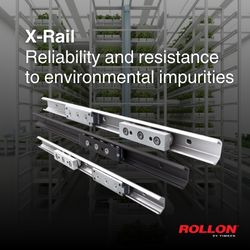In this blog, Pure Green we’ll describe the journey that water takes through a hydroponic system like ours, from the second it enters the unit to the minute it exits.
Water’s Journey: Inside a Hydroponic Container Farm
Article from | Pure Greens Container Farms
Water savings is one of the biggest benefits of growing crops inside a hydroponic container farm. While we’ve written about how growing with hydroponic methods can cut water usage, we haven’t described how water flows through the system, or explained the details of how hydroponics can achieve stellar water savings.
In this blog, we’ll describe the journey that water takes through a hydroponic system like ours, from the second it enters the unit to the minute it exits.
We’ll describe how different components work together, ensuring that the water supply flows through the system to provide every part of the unit with a refreshing nutrient solution. If you’ve ever been curious about seeing how a hydroponic system works, this is the blog for you.
The Journey Begins
Our campaign begins with a typical garden hose. Just like how you’d use a garden hose to water a soil-based garden, a hose is the first step to providing your container farm with water. There’s a spot at the back of the container that attaches to the hose, with a valve to change the flow’s intensity.
You don’t have to filter the water or do anything special, almost any water will do. The magic begins once the flow enters the container farm. Inside, the water mixes with a nutrient concentration and becomes purified through the reverse osmosis process. There, we find the real value of this liquid.
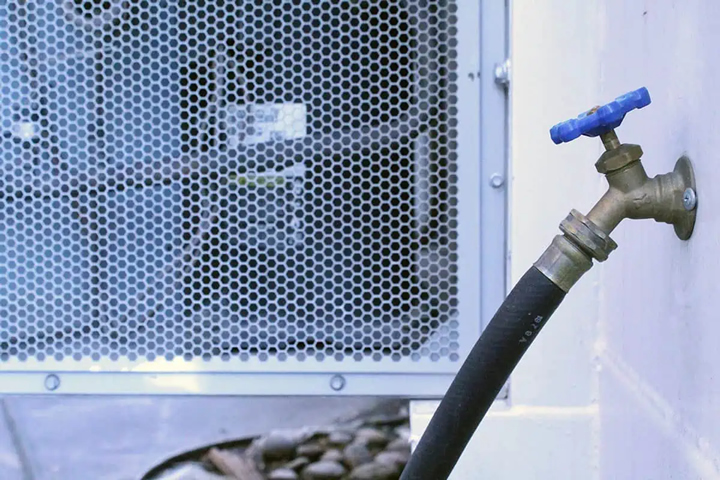
Pure Greens Container Farms have standard garden hose connection spigots for hassle-free water hookups. However, during subfreezing temperatures (below 32°F or 0°C), it is necessary to insulate the water line to avoid any water access issues.
Inside, Where to Next?
After water enters the container, it flows inside pipes that lay along the bottom edge of the container’s interior. Once the water starts flowing, the pressure behind the flow will ensure that it travels smoothly through each stage of the system.
The next stop on water’s journey is the nutrient solution reservoir, but before we discuss that, let’s provide some foundation for what needs to happen to the water before it’s mixed with nutrients.
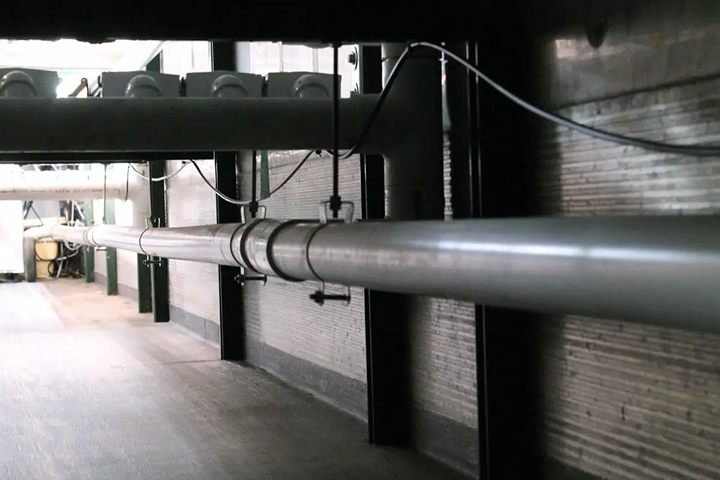
Underneath the grow area, water can flow to the nutrient reservoir.
Reverse Osmosis
Inside the nutrient reservoir we have a system that performs reverse osmosis (RO). The process of reverse osmosis demineralizes the water, pressuring water through a semi-permeable membrane.
This is to ensure the removal of dissolved salts, particles, colloids, organics and bacteria from the feed water before you can add it to a nutrient mix. After purifying the water, it can mix with nutrients inside the reservoir.
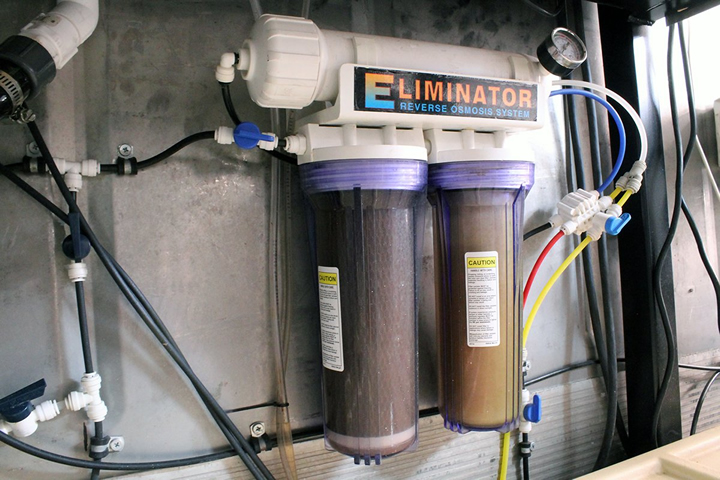
Reverse osmosis systems are widely used in commercial industries, in households, and for hydroponic production.
The Nutrient Reservoir: A Hydroponic Heart
This is where all the action happens. Water enters the reservoir near a float valve, a hollow, sealed float that ensures that the nutrient reservoir has enough liquid, but not too much that it overflows.
Once inside the reservoir, the water mixes with nutrients, typically a chemical mixture known as NPK: Nitrogen, Phosphorus and Potassium.
While these are the primary group of nutrients that plants require, you may also see Calcium and Magnesium (CalMag) used to feed plants. The rapid absorption of essential nutrients enable the rapid plant growth that hydroponics boasts of.
After mixing the solution, the loop can begin. Here’s where hydroponics’ water savings really come into play. The solution is first pushed through a water chiller, that reduces the temperature of the nutrient solution to a level that’s comfortable for the plants to absorb. At commercial scales, a water chiller is essential to ensuring optimal growth, and it plays a key role in controlled environment agriculture.
Direct Delivery
After chilling, the solution moves to two separate pipes that bring the flow to either side of the container farm. Then, a series of pipes distributes the solution to every growing tray in the system, providing each level of plants with an even level of solution.
The plants’ roots dip down into this flow, allowing each to absorb the nutrient-rich solution precisely, ensuring a consistent and optimal supply for their growth. The orchestrated distribution system plays a crucial role in maximizing efficiency and promoting a uniform distribution of solution across the entire container farm.
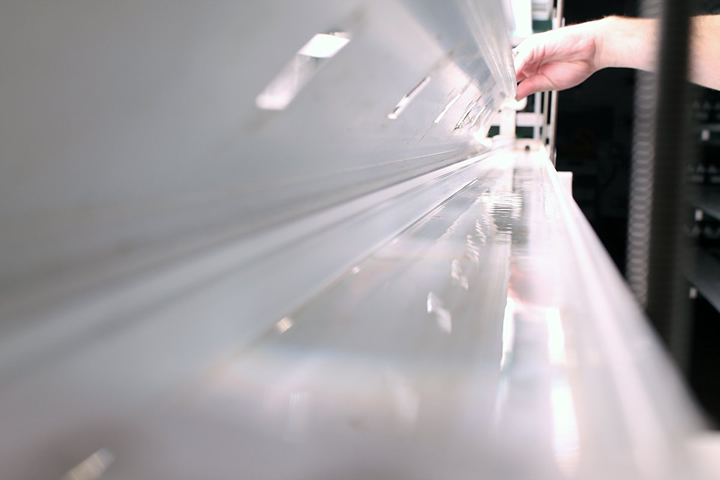
These grow trays hold plants in the holes on the top of the tray. Below, nutrient solution can flow, providing nourishment to all the plants in the system.
Exiting the Container – The End?
Wastewater from the reverse osmosis process leaves the system in addition to overflow water that comes from the nutrient solution reservoir. This water may contain a higher percentage of dissolved solids (minerals, salts and organic matter) as a byproduct of the RO process, and can’t be reused as a system input.
However, that doesn’t mean that you can’t use this water for anything. You can use it to water outdoor plants or use it to clean messy floors, dirty windows or dusty cars.
Our Head Grower said certain plants (namely heavy fruiting plants like tomatoes, peppers and eggplants) are more sensitive to the higher levels of minerals left in the wastewater, but certain plants can thrive in those circumstances, like carrots and onions.
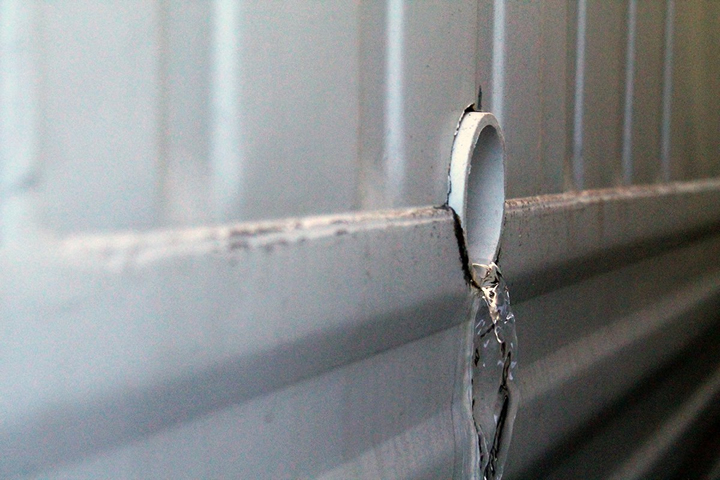
Water leaves the system through a port located on the side of the container.
What Does It All Mean?
The combination of water, nutrients, and hydroponic technology inside a container farm results in a closed-loop system that maximizes efficiency and minimizes waste. It’s a sustainable approach to agriculture that not only saves water but also provides a controlled environment for optimal plant growth.
The water savings of hydroponics comes from the fact that the same nutrient solution can be reused for several weeks, while in soil-based farming, most of the water is transpired as water vapor.
While a traditional farmer might be watering crops several times a week during dry periods, a hydroponic farmer only needs to add a little bit more every week to top off the supply.
The water that the farmer uses is “spent”, while nutrient solution can make cycle-upon-cycle and continue to provide plants with necessary hydration and nutrition. While the nutrient solution needs to be replaced about once a month, overall water usage is dramatically reduced.
Additionally, these water saving effects are more pronounced in dry climates, as traditional farmers can’t rely on rainfall in the same way that farmers in rainy climates can.
Summary
Embarking on the journey of water within a hydroponic container farm unveils a remarkable tale of sustainability and resource efficiency. Starting with a humble garden hose, the water undergoes a transformative process inside the container, merging with essential nutrients and undergoing reverse osmosis purification.
This system ensures the nutrient solution reaches each corner of the container farm, fostering rapid plant growth. Notably, the closed-loop system incorporates a water chiller, optimizing the temperature for plant absorption, and creating a space for controlled environment agriculture.
Curious about how you can grow crops in a way that maximizes water savings? Contact us, and we can discuss how our pre-designed and custom container farms can help your growing operations.
Originally Published on the Pure Greens blog.
The content & opinions in this article are the author’s and do not necessarily represent the views of AgriTechTomorrow
Comments (0)
This post does not have any comments. Be the first to leave a comment below.
Featured Product
